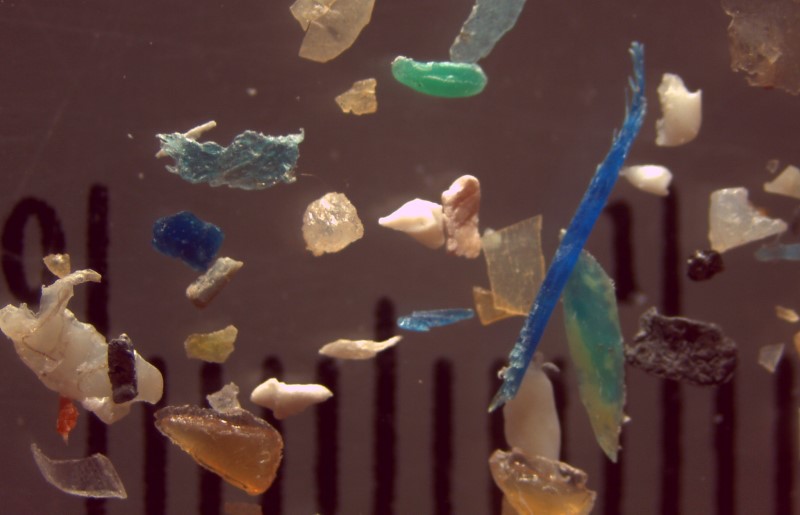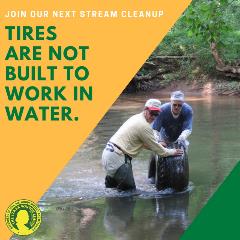During my backpacking days in the Big Sky country of Montana, I was able to reach remote mountain lakes and natural hot springs accessible only by hiking. Thanks goes, in part, to modern backpacks, which now can weigh less than 10 pounds.
How did backpacks get so light? Over the decades plastic materials were developed that offered many
benefits not only making gear extremely light-weight, but also more durable and water-repellent. Plus, manufacturers can imbed within the plastic other synthetic chemicals that make outdoor equipment fire- and UV-resistant, and even bug repellent. As the advertising slogan goes, “Plastics made it possible.”
For the past decade, I have been studying plastic pollution, focused primarily on its impact on fresh water. Sadly, what we have discovered is that plastic, and specifically microplastics, have invaded every corner of our environment: from the air we breathe to the water we drink to the soil we grow our food in, the very living skin of our planet.
 Microplastic fragments shown against a span of 10 millimeters. Countless fragments are invisible to the naked eye.
Microplastic fragments shown against a span of 10 millimeters. Countless fragments are invisible to the naked eye.
Why Worry?
Microplastic pollution is ubiquitous and results from the plethora of plastic items we all buy and use, whether backpacks or yoga pants. And this pollution is coming back to us—in the food we eat, the air we breathe and the water we drink.
With more than 10 billion metric tons of plastic having been produced since 1950 (roughly when it entered the consumer market), an estimated 10 to 15 percent of that plastic has found its way into our environment.
Understanding the impact of this contamination is the focus of scientific research on plastic pollution. The early signs are not good.
The synthetic chemicals added to plastic, like UV stabilizers and flame retardants, are known to be endocrine disruptors, which mimic hormones. Because hormones are the chemical messengers of the body, endocrine disruptors mess up all sorts of signals and communications in our bodies. This leads to a myriad of serious human health outcomes, from decreased sperm counts and pregnancy viability to increases in certain types of cancer and other diseases. These health consequences are triggered by the chemicals within the plastics. We don’t fully understand the potential impacts of the plastics themselves, which is where current studies are focused.
The creation of plastic from its fossil fuel sources is another huge pollution problem of its own, and an environmental justice issue to boot. Refineries are routinely located in lower-income communities and those with higher populations of people of color. These same communities suffer higher incidence of certain cancers and respiratory diseases, leading the area along the Gulf Coast of the United States to be known as “Cancer Alley.”
For all the talk about the durability of plastic, we have all seen how it comes apart—when some plastic clip, utensil or other item breaks. The durability of plastic doesn’t mean that it won’t break. It means that it won’t break down—that is, it can’t be decomposed and returned to its elemental state (i.e., the carbon and hydrogen from which it is made).
Why doesn’t plastic readily decompose? Most natural decomposers (which include certain bacteria, fungi and insects) can’t use it as a food source. That’s why no matter where you wander you can’t escape seeing some plastic bag caught in a tree or scattered fragments of red solo cups.
Over time, largely through mechanical actions, plastic will break into smaller pieces. These ever-smaller pieces are called microplastics once they reach 5 millimeters (see photograph above) or smaller, and of course countless fragments are reduced in size until they are invisible to the naked eye.
Solutions: Reduce, Reuse, Replace
 Through stream cleanups nationwide, Izaak Walton League volunteers have been removing plastic and other trash from our waterways for many decades. Today, this community-based conservation continues to reduce microplastics in the nation's water.
Through stream cleanups nationwide, Izaak Walton League volunteers have been removing plastic and other trash from our waterways for many decades. Today, this community-based conservation continues to reduce microplastics in the nation's water.
Like any addiction, the first step toward ending it is admitting to it. Let there be no doubt—we, as a society—are addicted to plastic.
There are things we can do. First and foremost, we can reduce our use of this material. I advise people to start with one product at a time and find a non-plastic replacement. Some of these are easy: Bring your own reusable cloth bags to the store. Use a refillable water bottle and coffee mug. Buy wool or hemp clothing instead of synthetic. Other items are harder to replace but alternatives exist: shampoo and conditioner in stainless steel refillable containers, toothpaste in tablet form or glass jars, sunscreen in metal jars and bug spray in stainless steel spray bottles.
When reducing isn’t possible, think about reusing. I have friends who are especially gifted at shopping second-hand stores. There are even communities that have created tool libraries and repair workshops focused on reusing and fixing rather than replacing. There are also on-line stores, like Gear Trade and Out&Back Outdoor, that allow you to buy and sell used equipment.
When you do have to buy something new, remember the old adage: you get what you pay for. The point is choose quality items that will last. You can also use your dollars to support companies that recognize the problem and are trying to be part of the solution. In the arena of outdoor gear, Patagonia is engineering synthetic materials that shed less.
Beyond individual actions, lend your support to legislation such as the Break Free from Plastic Pollution Act of 2021, S. 984, which moves the responsibility for plastic pollution from consumers to companies. As corporations design the products we purchase (and produce 70 times the waste in the process) this is ultimately where the solutions lie.
We are all part of the problem of plastic pollution, but that means we are all part of the solution. Remember to leave no trace: pack it in, pack it out and find ways to eliminate unnecessary plastics from your life.
Maybe then we can all enjoy the great outdoors without finding that proverbial plastic bag blowing in the wind or that red solo cup ruining the scenery.
A similar story can be told for any number of plastic products—each polluting through the additional pathways of littering (either accidental or intentional) and leading to direct contamination of water and soil.
Follow the Yoga Pants
How do plastics end up so ubiquitous a pollutant? Let’s take a product, like a pair of yoga pants, as an example.
First, the pants are crafted from synthetic threads. Anyone who has sewn an article of clothing can tell you about all the little threads that are lost in the process of sewing. These threads, termed microfibers, can easily become airborne and depending on their size travel hundreds to thousands of miles. Air samples from the Pyrenees Mountains to the national parks in the Western U.S. to the Arctic have all shown this type of contamination. These airborne microfibers also lead to water and soil contamination when these particles fall out of the air, which is how the samples from these regions were collected.
Once our clothing item is made, we bring the items home to wear and then wash. Studies have shown that a single garment made from synthetic materials can shed more than 1,900 microfibers in a single wash. While wastewater treatment plants weren’t designed to remove this type of contaminant, they are still surprisingly effective at pulling microfibers out of the water. But they still end up somewhere, in this case in sewage sludge, which is frequently used as a soil amendment on farmland.
So, the wastewater treatment simply moves the microplastics to our soil. Here rainwater can move them off the soil into waterways through run-off. Or it can move the plastic particles through the soil though percolation. Some studies have shown microfibers making their way from the soil into plants or into aquifers.
Plastic microfibers from synthetic clothing circulate into our air, our soil and our water. In total, textiles represent one of the largest sources of microplastic pollution with current estimates topping 2.2 million tons per year.
This article was excerpted from “Outdoor America” 2021 issue #3. Want more articles like this? Join the League and get four issues of our award-winning magazine every year.
Join the Izaak Walton League
Sherri A. Mason, Ph.D., Professor of Chemistry and Director of Sustainability at Penn State Erie, The Behrend College, is a leading expert on freshwater plastic pollution.
Top photo: On Lake Erie near Buffalo, NY, author holds a Manta Trawl, used to collect microplastic samples. Photo credits: Sherri A. Mason.